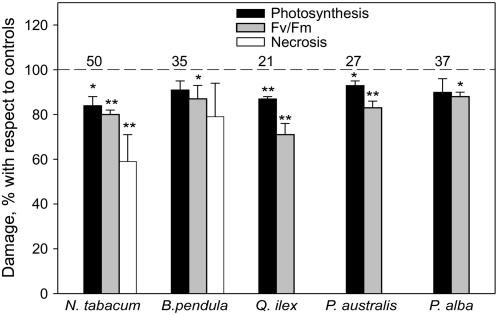Figure 3.
Ozone damage in leaves naturally emitting volatile isoprenoids (holm oak, common reed, and white poplar) and in leaves of plants that do not emit isoprenoids but were fumigated with 3 μL L−1 of exogenous isoprene during the ozone treatment (reed and birch). Ozone (100 nL L−1) was fumigated consecutively for different times to illuminated leaves, as indicated in the text. Damage indicators were the reduction of net photosynthesis and of maximal quantum yield of chlorophyll fluorescence in dark-adapted leaves (Fv/Fm), measured 12 h after the ozone treatment, and the reduced appearance of visible necrotic areas in the leaf lamina, measured 7 d after the treatment. Visible necrotic damage was assessed only in intact leaves of tobacco and birch, not in those leaves that were cut to feed the isoprenoid inhibitor. All damage indicators are shown as percentage of the level measured in leaves that do not emit naturally isoprene or in which isoprenoid emission was previously inhibited by fosmidomycin, as indicated in the text (dotted horizontal line). The numbers above the dotted line indicate the reduction of photosynthesis (%) caused by the ozone treatment in leaves that do not naturally emit isoprene or in which isoprenoid emission was previously inhibited by fosmidomycin, with respect to the nonfumigated controls. Measurements were repeated on five different leaves per species. Means significantly different from 100% (the damage measured in leaves without endogenous or exogenous volatile isoprenoids) are separated by ANOVA using a multiple range test (P = 0.01, double asterisk; P = 0.05, single asterisk).

